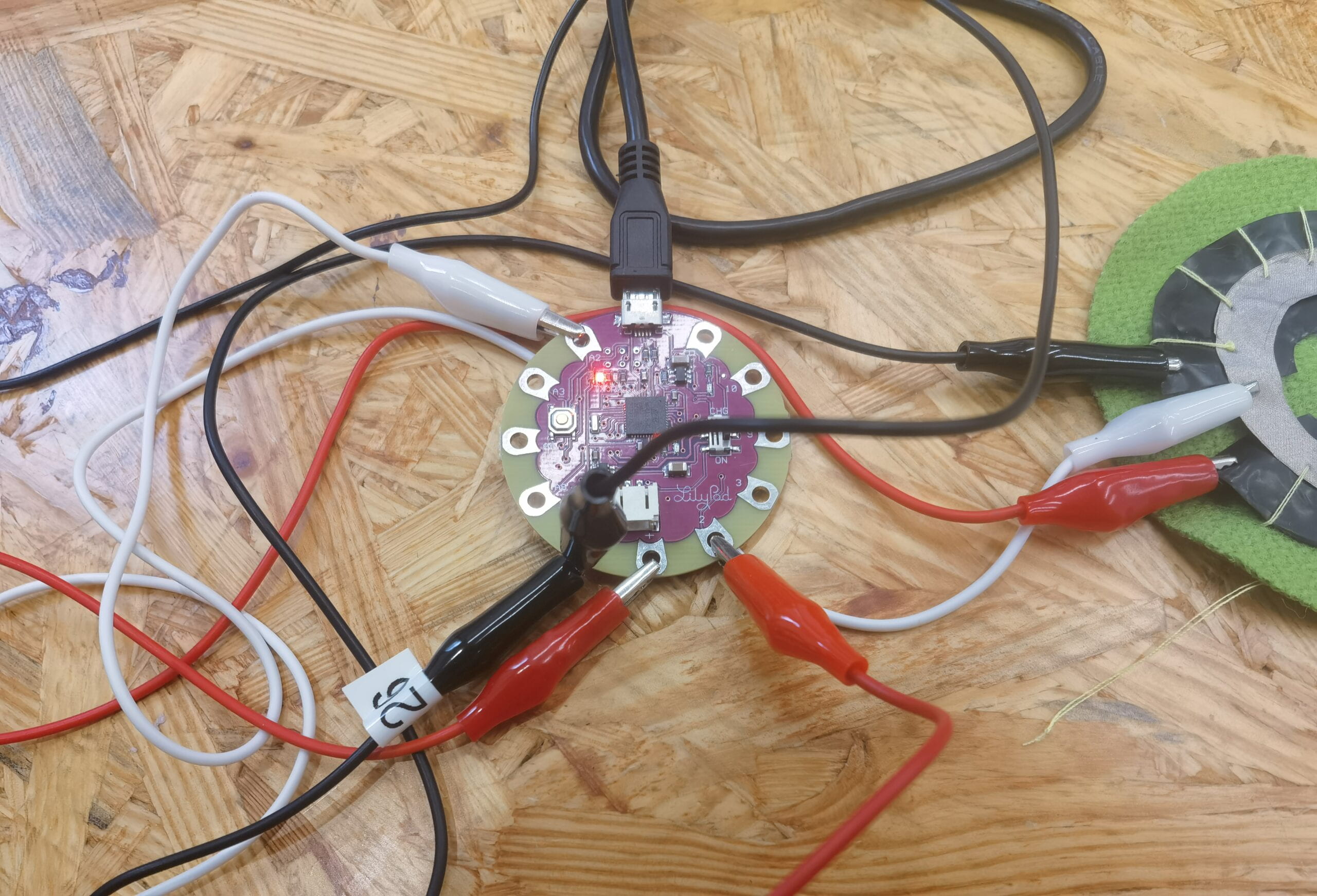In-class Recitation: Circular Potentiometer
Annika and I made this circular potentiometer using velostat and conductive fabric. Building the sensor was not difficult, after cutting the two circular fabric, Annika sewed them with a piece of normal fabric to secure them.


Though I have been away from Arduino codes for roughly two years, luckily, the codes for this circuit is very simple. It takes an analog input from the potentiometer sensor, maps the value into a certain range, and outputs it to the LED. Such simple code is attached at the bottom of this section. The circuit is also straightforward, the circular sensor is connected just like the normal potentiometer, one 5V, one analog input to Lilypad, and one ground. LED is connected with the input from Lilypad, one 220R resistor and then to the ground.


The most challenging part was to connect the Lilypad with the laptop and upload the codes. Even after choosing the correct port and verifying the codes, we failed to upload it many times. While the codes was successfully uploaded to the Lilypad at last, we still don’t know what went wrong and why it worked.
The circular sensor works in an intuitive way that as you moves your finger around the circular fabric, the input signal changes. To be specific, when your finger is close to the positive end, the end connected to the 5V, the sensor has higher outputs; the numeric number drops when your finger moves away. In our circuit, such changes is reflected in the brightness of the LED. The LED dims when your finger moves towards the ground end. However, our circuit did not work that smoothly, because even when no one touches the sensor, it still has an output around 400, and the numeric changes from the sensor is not that big. One potential way to improve the circuit would be the transform the sensor output. For example, we could try to subtract the base number (400) from the output, and then square (or take absolute number of) the result, and then map the numbers correspondingly.
const int sensor_pin = A2; const int light_pin = 2; int sensor_value = 0; int brightness = 0; void setup() { Serial.begin(9600); pinMode (light_pin, OUTPUT); } void loop() { sensor_value = analogRead(A2); Serial.println(sensor_value); sensor_value= constrain(sensor_value, 500,600); brightness = map(sensor_value, 500, 600, 0, 255); analogWrite(light_pin, brightness); delay(100); }
After-class Assignment: Wearable Device
After brainstorming for quite a long time, Annika and I wanted to make something that would to some extent limit human perception. However, due to the very limited resources, as we had nearly no materials, we were not able to build exactly what we have in mind. At last, we built two locks, one that locks human movement around neck and arms, the other that locks human visions.


We first gathered around all the materials we had, which were some feathers, tapes, a plastic bottle, and some chopsticks. After exploring some potential ideas, we decided to make full use of the plastic bottle. We cut the two ends of the bottle, then used fire to bend the plastic, so that it looks a little bit like an octopus. By doing so, we built our first lock, a monocle-like lens. When people look through this lens, due to its long width, he or she loses all the afterglow of what he or she sees, and thus forced to focus on what is right in the center of the cause. In this way, this lens locks human vision to only the center part.

In addition to the lens, we made a second lock, which restricts people’s physical movement. Inspired by ancient Chinese shackles, we used sticks and tape to make this “lock”. We didn’t want the device to become a physical torture, so we made the lock very loose to make it easier to wear. When wearing this lock, the physical distance between one’s neck and wrists are fixed, so that people cannot easily move their heads or arms in any direction.

We want to emphasize human attention to other people, or other objects. Although we would normally look at the exact target when we wanted to focus on something, we would actually be easily distracted by all our surroundings, such as movements you captured in your afterglow sight, the other human or even the pen in your hand. We built these two locks trying to help people get their attention back, by limiting their vision and physical actions. The yellow-black tape was widely used in crime scenes to show alarms and convey the idea of forbidden and limits. We adapted such concepts of limitation into our design of the locks. We hope that through this feeling of limitation, people would reconsider their attention with the outside world and with their inside concentrations.